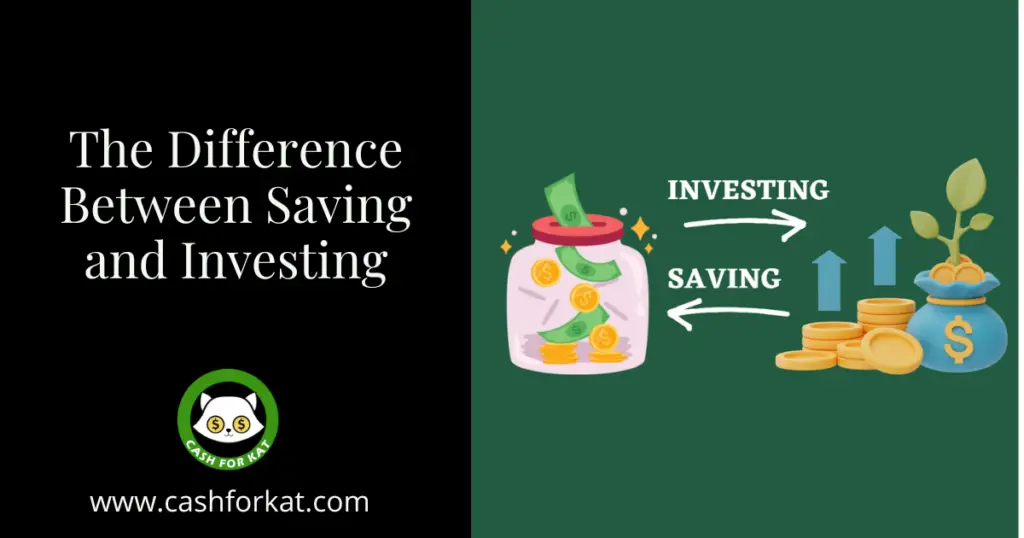
The Difference Between Saving and Investing
When it comes to planning for your financial future, understanding the differences between saving and investing is essential.
Saving and investing are two concepts that are often confused for one another due to their similar goals of achieving financial security. However, they have distinct differences that are necessary to understand when choosing the right option for you.
In this article, I’ll explore the key differences in order to help you make an informed decision about which option is best suited for reaching your financial goals.
What’s the difference between saving and investing?
The main difference between saving and investing comes down to timing.
In a nutshell, putting savings away is ideal for near-future planning. Investing, on the other hand, will likely benefit you in the long run.
This is because people tend to save their money in more stable locations, such as a savings account or certificate of deposit. However, investments are dicy as their value fluctuates with market conditions.
There are also a wide variety of investments to choose from, which can be quite complex. Depending on the investment you select, you may have to deal with fees, extreme price volatility, and so on. Investing can also have many different tax implications depending on how you invest. For example, taxes can depend on if you receive capital gains, long term gains, dividends, etc.
If you are new to managing your money, starting with savings is a great way to get started! You’ll probably want to add in investments over time and with adequate research.
Read on to learn more about the difference between saving and investing!
What Is Saving?
Saving is simply putting money aside. This is a broad definition because saving can look different for everyone.
Kids might start saving by putting spare change in a piggy bank. Adults might save by automating their savings or putting away financial windfalls.
People save for various reasons, but it’s typically for short-term financial goals such as creating an emergency fund, going on vacation, or purchasing a car.
Why is saving important?
Saving money is important because it allows you to be prepared for unexpected expenses. At the same time, putting money aside allows you to work towards larger financial goals. Some purchases, like a house, usually can’t be bought with one month’s paycheck!
The Bank of America’s 2022 Consumer Saving and Spending Report found that over 44% of Americans want to increase their savings in 2023.
The most common type of savings involves putting cash into a bank credit deposit account. These accounts allow you to earn some interest over time. The financial risks of saving are minimal, and they can only occur due to inflation.
Saving is a great segue into learning how to budget. Knowing that you’ll always have some cash can definitely build financial security.
Pros of Saving
- Funding short-term financial goals
- Collecting money for an emergency fund
- Minimal loss risk
- Minimal fees
- Easy to do
- High liquidity
Cons of Saving
- Low returns
- Possibilities of losing money due to inflation
What Is Investing?
Investing is a money building strategy that allows you to put cash into financial tools such as stocks, bonds, mutual funds, or ETFs. Unlike saving, which carries little to no risk, investing involves more risk–but it can also offer a higher return rate.
Investing is a great way to accomplish your long-term financial goals. For example, If you learn how to invest, you’ll be able to save for future endeavors like for college tuition or to start a retirement fund.
A downside of investments is that they can carry risk. To avoid this, try to look for investments that align with your goals, risk, and time expectations to get the best possible outcome. This way, you’ll be able to start an income stream.
Pros
- High returns
- Can help you achieve long-term financial goals
- High liquidity
Cons
- The returns are not guaranteed
- Possibility of losing money
- Requires research and previous knowledge
- High fees
- May take a long time
How Can I Invest?
Before investing, it’s important to talk with an advisor. They can guide you toward particular investments that are appropriate for meeting your desired goals. They can also make sure that you understand all of the associated risks before making any commitments.
Saving vs. Investing
| Characteristics | Saving | Investing |
| Account type | Bank | Brokerage |
| Return | Typically low | Potentially high, but could also be low |
| Risk | Almost no risk | Varies by investment |
| Timeframe | Short | Long, typically over 5 years |
| Difficulty | Easy | More challenging |
| Protection from inflation | Little to no protection | Depends on the fund expense ratios |
| Liquidity | Typically high | Typically high |
How Are Saving and Investing Similar?
Both saving and investing can help you reach your financial goals and accumulate money.
Although the end goal may be the same, these strategies function entirely different from one another.
3 Differences Between Saving and Investing
In a way, saving represents a safer option than investing. This is why it’s a great option for short-term financial goals and people who are still working on building their wealth. Investing is typically riskier, but it carries fruitful benefits for the investor. In comparison to saving, investing leads to higher profits
Below is a list of the four biggest differences between saving and investing
1. Typical Products
One of the biggest differences between saving and investing is the typical product these strategies use. Saving mainly relies on certificate of deposits, savings accounts, and money-market accounts. Investing relies on bonds, stocks, mutual accounts and ETFs.
2. Risk Level
Another major difference between saving and investing is their risk level. Saving typically carries little to no risks—the only risk associated with saving is inflation. Inflation can reduce the value your savings over time due to the increase in prices and currency value changes.
On the other hand, investing carries a much higher risk that varies per investment. Investing doesn’t guarantee you a return, meaning that some investments you make may lose the money you initially invested.
As investing carries higher risks, it’s essential to get familiar with the practice and educate yourself before actually making your first investment.
3. Timeframe
Savings are mainly required to accomplish short-term financial goals. These can include saving up for a down-payment on a car or for making a big purchase. On the other hand, investing is more time consuming, which is partially why it allows you to accomplish more long-term financial goals.
The difference between the two can be measured in 5 years. To explain: Most short-term savings can happen within 5 years, while most investments take over 5 years to allow you to get a high return.
4. Difficulty
Last but not least, the biggest difference between saving and investing is the difficulty level. Saving can be tricky, but tends to be the easiest. Starting to save requires no research and you can learn how to budget and manage your finances properly over time.
Investing requires much more research and knowledge. Knowing what stock to select isn’t just information you can find quickly.
Because of that, you should never start investing unprepared. Instead, try to familiarize yourself with investing by speaking to a financial expert.
When To Save vs. When To Invest?
Many people find themselves questioning if they should save or invest. The truth is, there’s no one-size-fits-all formula for choosing between the two. Instead, you should consider your current financial situation to determine if saving or investing would be a better option for you.
Here’s a chart that should help you learn when to save vs. when to invest money.
| When To Save Money | When To Invest Money |
| If you have short-term financial goals you want to accomplish | If you have long-term financial goals you want to accomplish |
| If you haven’t built an emergency fund yet | If you already have some savings and an emergency fund |
| If you have debt you need to pay off | If you are debt-free |
Final Thoughts
Saving and investing both have important roles when it comes to planning for your future. Creating a savings plan tends to be easier than the process of creating investments. Investing proves time and energy consuming although the profit margin is larger. Regardless, it’s best to appropriately assess your financial situation before making any kind of decision. Understanding these key differences will help ensure that you make a plan that works best for you.

